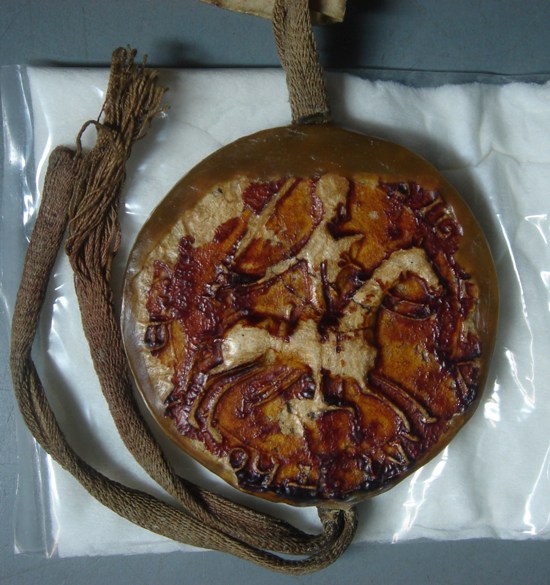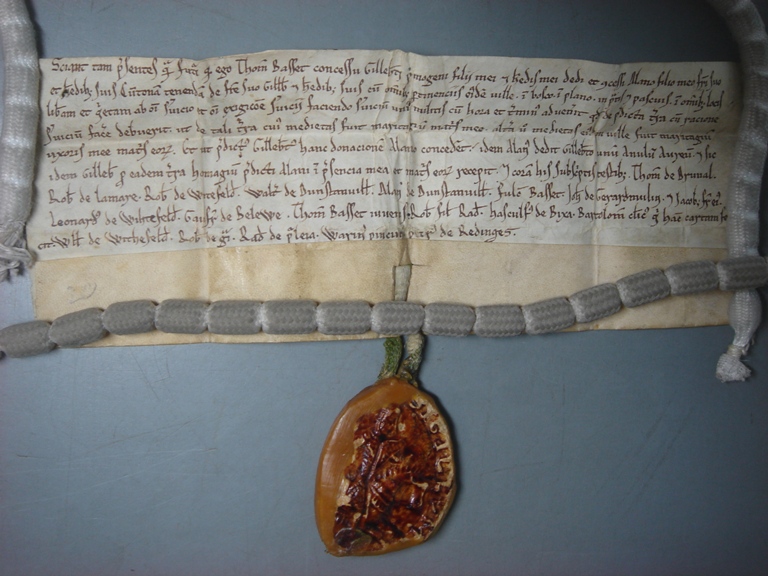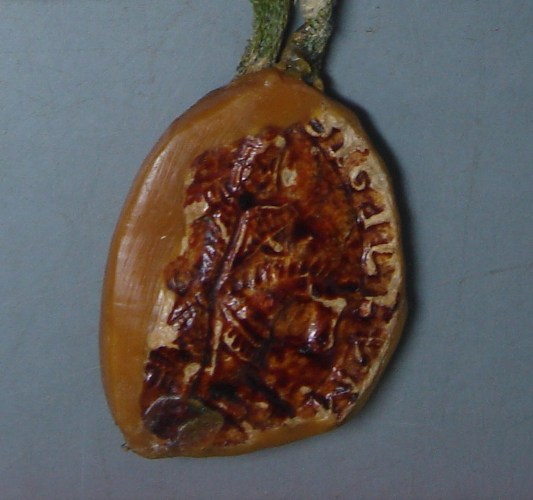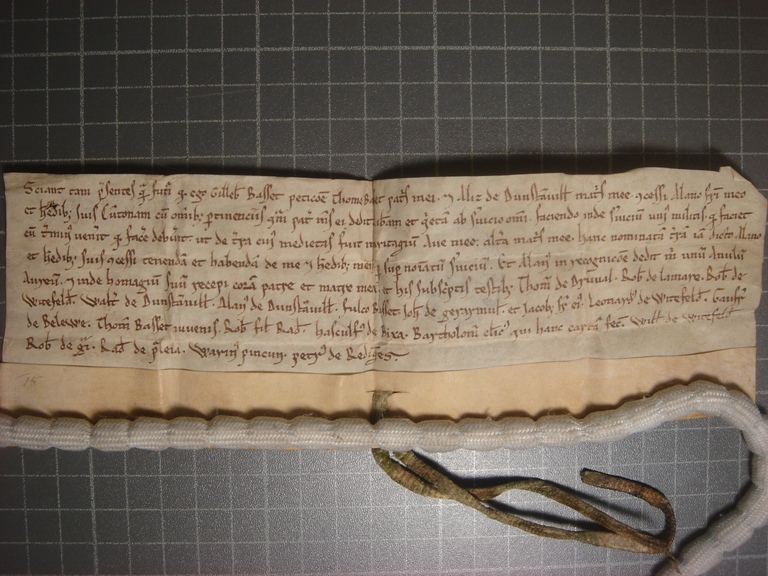Fine of the Month: June 2010
(William Stewart-Parker)
1. Fine of the Month – Methodological Problems of Standardisation in Medieval Source Material: The Compton Bassett Charters
Editing medieval records is a process fraught with difficulties and differences of approach and opinion. Nowhere is this more true than in identifying and modernising, or not, personal and place names. Here, while not specifically addressing an individual entry, or entries, in the Fine Rolls, William Stewart Parker examines what variant spellings and the general diplomatic conventions might tell us about the processes, administrative and ceremonial, behind the production of charters of land conveyance.
⁋1In preparing an edition of the Fine Rolls of the reign of Henry III, the editors have had to contend with the problem of standardising the forms of Christian names, place names and surnames. In doing so the editors have stated that ‘All place names which can reasonably be identified have been modernised, including those that form a surname’ and have preserved the different forms in the indexes. 1 The purpose of this ‘Fine of the Month’ is to demonstrate how much such place name forms can vary even within a single transaction dealing with the same people and the inherent difficulties this produces. The article will then go on to consider the complex relationship between the charters of this conveyance themselves, which will throw light on the question of how charters were witnessed and produced.
⁋2The three charters this paper will consider concern the granting of land in Compton Bassett, Wiltshire, by Thomas Basset (d. 1182) to his son, Alan, between 1180 and 1182. Thomas was custodian and lord of the Honour of Wallingford under Henry II and Alan, with his brothers Gilbert and Thomas, would go on to follow his father into the service of the Angevin kings.
⁋3The first of the three charters, The National Archives, Kew (hereafter TNA), E 40/4612 (hereafter Charter 1), records the grant by Thomas Basset to his son, Alan, of his whole manor of Compton, along with land in Berwick (both in Wiltshire), to be held for one knight’s fee. 2 Such a grant was often carried out to provide a younger son with a landed base. Glanvill, the great law book of the age, makes clear that such a concession could only be made in the lifetime of the father, as upon his death the land would revert to his first born son and heir; in this instance that would been Alan’s brother, Gilbert Basset (d. 1205). 3
-

- E40/4612: Grant by Thomas Basset of land in Compton Bassett and Berwick to Alan, his son, 1180x1182
-

- Seal of TNA E 40/4612
⁋4The second charter, TNA E 40/4828 (hereafter Charter 2), supposedly also a charter of Thomas Basset, unlike Charter 1, specifies that the grant of Compton (no mention is made in this instance of the land in Berwick), made by Thomas to Alan, was done with the permission of Gilbert Basset, Thomas’ first born son. This followed the prescription in Glanvill that any diminishment of the family patrimony had to be done with the heir’s permission. 4 The charter furthermore specifies the origin of the land which would make up Alan’s holding in Compton, half of which came from Thomas’ own mother’s marriage portion and the other from the marriage portion of the mother of his wife, Alina de Dunstanville. 5 It then goes on to give far more detail than the first charter of the ceremony conducted to validate the conveyance; Alan gave Gilbert the token of a gold ring and did homage to his brother for the land in the presence of his parents and the assembled witnesses.
-

- E40/4828: Grant by Thomas Basset of land in Compton Bassett to Alan, his son, 1180x1182, with details of the ceremony to validate the conveyance
-

- Seal of TNA E 40/4828
⁋5The third charter in the series, TNA E 40/4847 (hereafter Charter 3), purports to be the concession by Gilbert Basset of the same property, done so as it states, at the bequest of his father and mother. 6 It has the same details in content as Charter 2, altered to Gilbert’s perspective and records the ceremony of homage and ring giving. Apart from a slight variation in the spelling of names for the witnesses – Wihtefeld, Witefeld, Withefeld – the names given in the two charters are identical. 7
-

- E40/4847: Grant by Gilbert Basset of land in Compton Bassett to Alan, his brother, 1180x1182
⁋6Table 1 highlights how the issues of a lack of standardisation can even affect the witness lists of three charters describing the same event and supposedly produced around the same time:
| Table 1. Variation of Spelling and Case in Witness Lists for the Compton Charters | ||
|---|---|---|
| E 40/4612 (Charter 1 | E 40/4828 (Charter 2) | E 40/4847 (Charter 3) |
| Clerk ‘X’ | Clerk ‘Y’ | Clerk ‘Z’ |
| Thoma de Druual | Thomas de Druual | Thomas de Druual |
| Roberto de Mara | Robertus de Lamare | Robertus de lamare |
| Roberto de Witefeld | Robertus de Witefeld’ | Robertus de Witefeld’ |
| Waltero de Dunstanvile | Walterus de Dunstanvill’ | Walterus de Dunstanvill’ |
| Alano de Dunstanvile | Alanus de Dunstanvill’ | Alanus de Dunstanvill’ |
| Fulcone Basset | Fulco Basset | Fulco Basset |
| Johanne de Gerardmulin | Johannes de Gerardmulin | Johannes de Gerarmul’ |
| Jacobo fratre eius | Jacobus frater eius | Jacobus frater eius |
| Leonardo de Witefeld | Leonardus de Wihtefeld’ | Leonardus de Witefeld’ |
| Galfrido de Beleve | Gaufridus de Belewe | Gaufridus de Belewe |
| Thoma Basset juuene | Thomas Basset juuenis | Thomas Basset juuenis |
| Roberto filio Radulfi | Robertus filio Radulfi | Robertus filio Radulfi |
| Hasculfo de Bixe | Hasculfus de Bixa | Hasculfus de Bixa |
| Bartholomeo clerico ‘qui hanc cartam scripsit’ | Bartolomeus clericus ‘qui hanc cartam fecit’ | Bartolomeus clericus ‘qui hanc cartam fecit’ |
| Willelmo de Witefeld | Willelmus de Withefeld’ | Willelmus de Witefeld’ |
| Roberto de Gray | Robertus de Grai | Robertus de Grai |
| Radulfo de Purlay | Radulfus de Purleia | Radulfus de Purleia |
| Warino Pincun | Warinus Pincun | Warinus Pincun |
| Petro de Rading | Peter de Redinges | Peter de Redinges |
⁋7We will see later that despite recording the same event and Bartholomew the clerk being associated with their production, Charters 2 and 3 do not seem to have been produced at the same time as Charter 1. Nonetheless, the difference in spelling between the first and latter two charters is still striking as is the fact that the witness lists differ in case.
⁋8Aside from its relation to the series of charters as a whole, Charter 1 raises questions of its own. Firstly the charter is markedly different from the other Compton charters of the series. The charter is the only one that explicitly states that Bartholomew ‘wrote’ the charter and the style appears to be an earlier twelfth century hand compared to the one used in the other two charters. It is perhaps for this reason that W.T. Reedy, in his edition of Basset Charters, expresses some doubt over the authenticity of the charter. 8 Despite the claim that Bartholomew wrote it, the charter appears to have been written in two different hands – one for the body of the charter and another for the witness lists. While similarities in style are present, the manner in which ‘h’ is written, for example, and even the way ‘g’ is written before the tail is added, 9 there are significant differences particularly in the manner in which ‘t’, ‘w’ and ‘a’ are written. The problem of authorship is further compounded by the irregular style of both the body of the text and witness lists. As Michael Clanchy has highlighted just as medieval writers did not usually aim at absolute uniformity in the spelling of proper names and the use of capital letters and punctuation, they likewise varied their scripts. He cites the example of two charters of Robert Mauduit, King John’s chamberlain, which are both explicitly stated to have been written by Louis, clerk of Rockingham, yet the charters differ so much, quite gratuitously, in their scripts and conventions that only the most expert palaeographer would have attributed them to the same scribe. 10 What is clear however, is that in Charter 1, there is a marked break in the writing style between the body of the charter and its witness list, which is written in a quicker and stiffer fashion. This suggests not only a possible break in authorship but also of time between the production of the body of the charter and witnesses list.
⁋9The break between the body of Charter 1 and the witness list raises several possible scenarios of its production and the manner in which it was witnessed. As Dauvit Broun has suggested in a recent article for the Paradox of Medieval Scotland project, it seems natural to assume that everyone mentioned in a witness list was present when the charter was made. 11 However the break in the Compton charter suggests a marked gap between the writing of charter and its witness list. There are some instances in late twelfth century England and Scotland where a donor has written to individuals to ask if they would witness a charter which has already been drawn up, suggesting no witnesses were present at the drawing up of the charters. 12 Charter 1, could potentially fit this pattern, with the charter recording the donation being drawn up, followed by a community whip round by a clerk of the Bassets (possibly even Bartholomew) to get a list of names from local figures of importance and kin to authenticate the transaction, without them even witnessing the ceremony of the grant or ‘hearing’ the charter.
⁋10The possibility that the writing of Charter 1 and its witnesses were wholly removed from one another, however, is not entirely convincing. Those listed in the charter were all men local to the Bassets, or family relations, such as the Dunstanville family. All the indications are that absent witnesses were understood to be an irregular occurrence; when it occurred, it was because the charter was produced in haste, without time to assemble the desired witnesses. 13 But with Charter 1 there is still the issue of the clear separation between the body and the production of its witness list. This suggests that the charter was drawn up at a time before it was witnessed, but that then the donation was witnessed in the presence of those recorded in the customary ceremony which accompanied a grant of this type. Before such conveyances were made with documents, the witnesses ‘heard’ the donor utter the words of the grant and ‘saw’ him make the transfer by a symbolic object intended to impress the event on the memory of all those present. 14 These events did not end with the advent of drawing up charters. In the Bassets’ case, the names of those attending this ceremony could have then been added to the already prepared charter, written by Bartholomew before the ceremony – accounting for the rapidity in which it was written in comparison with the body of the text.
⁋11Further evidence that this was the case can be found in the two other charters relating to the grant of Compton to Alan Basset, whose witness lists are the same as the first charter. In both of these charters, the grant to Alan and the ceremony of homage which accompanied it, when Alan gave his brother the token of a gold ring, were recorded as being done in the presence of Alan’s parents, Thomas Basset and Alina de Dunstanville, and in the presence of those recorded as witnesses – et coram his subscriptis. 15 This is far more explicit than the first charter’s statement that Hiis testibus. 16 It affirms, in this instance, the importance of witnessing the ceremonial and hearing the terms of the conveyance, over witnessing the production of the charter itself.
⁋12Relating the first charter, granting Alan Basset land in Compton and Berwick, to the other two charters poses further problems. The difference in scripts used is marked, whereas Charter 1’s hand suggests the twelfth century for the date of its production, Charters 2 and 3 seem to be in an early thirteenth century hand. Bartholomew the clerk is again, as in the first charter attributed to their production, though his role is somewhat vaguer, no longer cartam scripsit, but cartam fecit. The differences between these two charters and the first, makes it difficult to believe they are contemporary with one another. This raises the question of their purpose, and when they might have been produced.
⁋13The main purpose of Charters 2 and 3 appears to be to clarify the grant of Compton to Alan by Thomas Basset, making clear both the assent of Gilbert Basset and the nature of property granted. They both make explicit that a ceremony took place when homage was performed to Gilbert, in the presence of the same named witnesses recorded in Charter 1. In turn they clarified where the land which would form the grant came from, namely the ancestors of both Thomas Basset and his wife, Alina de Dunstanville. Various hypotheses are possible for the production of the later two charters. For instance, the two may have been written up immediately after the first charter recording the grant by Thomas to Alan. This may have been demanded by both sons from their father to secure and clarify the land given and the obligation expected from Alan to his elder brother, Gilbert.
⁋14Perhaps the most likely scenario points to a later date of production. The dramatic change in style in the hand of the later two charters means that one cannot rule out that they were written considerably after Charter 1. One potential date, which stands out, when the charters may have been produced is in or around 1205/06. The reason for this date is that Gilbert Basset, Alan’s eldest brother, died sometime between Michaelmas 1205 and before 22 December that year. 17 Gilbert died leaving only one heir, his daughter Eustachia, who was married to Richard de Camville. 18 Camville may have been keen to secure his wife’s inheritance, which in turn may have provoked Alan Basset to seek further to secure his own claim to the land he held in Compton despite having held the land for over twenty years. Without Charters 2 and 3, the grant to Alan would have been undermined had Richard de Camville pursued the matter, as Charter 1 does not mention Gilbert’s consent or involvement in the grant from Thomas Basset. In light of this, Alan would have to have had Charters 2 and 3 produced and also found out his father’s seal, or if it had been lost or destroyed, made a copy to authenticate the documents. The inclusion of the same witness list implies that if the original charter had been inspected, these men could have been called upon to validate the grant.
⁋15It is interesting to note in this circumstance that no mention is made of the land in Berwick which Alan was granted by father in Charter 1. This might suggest that the charters were written up the year after Gilbert’s death in 1206. In June of that year Alan Basset had been granted the whole manor of Berwick by King John in perpetuity to be held at fee farm of £15 per year. 19 Alan may have therefore, at the time he commissioned the latter two Compton charters to be written, felt his properties in Berwick were secure by this royal reward or were soon to be so. The manor had been escheated to the crown before 1206 and Alan may have been subtlely lobbying the king for possession of the manor when it fell into the crown’s hands.
⁋16A further issues raised by charters 2 and 3 is the role of Bartholomew the clerk, the self-declared writer of the original Compton charter, Charter 1, in their production. Bartholomew appears as a witness in thirteen of Alan Basset’s charters, although, other than in the three Compton charters above, he does not claim to have been involved in the actual production of the charters. 20 Nor is Bartholomew’s hand present in any other of the charters. Though the majority of these charters give no indication of date, the clerk’s career can be observed from the manner in which he is labelled in the witness lists, firstly as ‘clerk of Compton’, then as ‘clerk of Alan Basset’ and eventually as ‘parson as Compton Basset’. 21 Bartholomew, who was still alive at the time of Gilbert Basset’s death in 1205, could have been called upon by Alan Basset, concerned to secure his own claim to the land in Compton which he held, to aid in the drafting of two further documents (Charters 2 & 3), using perhaps the original charter of the series and his memory of the ceremony that had taken place and the homage that had been performed for the lands. These were then copied or dictated to another scribe who wrote up the charters. While he wrote the first he may have only drafted the second, hence the way Charter 1 is said to be ‘written’ by him and 2 and 3 only ‘made’. 22
⁋17The evidence of the Compton charters helps shed light on the character of Alan Basset, as the most likely candidate who requested the drawing up of further charters after the original grant from his father of Compton. It shows an awareness not only of emphasising the importance of ceremony – the performance of homage and the recording of the token of a ring being exchanged, in the presence of witnesses – but also of the increasing nuances in the laws of inheritance regarding alienation of family land to younger sons. In the face of this, the productions of Charters 2 and 3 filled in the detail which the original charter lacked, as well as making up for that charter’s own poor quality of production by using a different scribe with a neater hand and clearer script. Furthermore, if they were produced at the request of Alan Basset, they reflect his own growing worldly wisdom in an increasingly litigious age. At some point before 3 May 1217 Alan was granted by Ralph Ramet, son of Gerard, the pasture of ‘Alwineia’ (Wix, Essex). 23 The first of three charters covering this grant specified that this land, which had previously been held by Thomas the tailor and Moses son of Hyldewar, was granted to Alan with the consent of Walter, Ralph’s eldest son and heir. 24 In two corresponding charters, which seem to be written in the same hand and have identical witness lists to the first, Walter son of Ralph confirmed his father’s grant. 25 It is highly likely that the impetus for producing these three charters, covering various legal issues of consent and the history of the land granted, had come from Alan Basset himself following on and having learnt from his own experience with Compton.
Footnotes
- 1.
- FRP Stylebook: http://www.finerollshenry3.org.uk/content/book/style_prac.html Back to context...
- 2.
- See also Basset Charters, ed. W.T. Reedy (London, 1995), no. 177. Back to context...
- 3.
- The Treatise on the Laws and Customs of England commonly called Glanvill, ed. and trans. G.D.G. Hall (London, 1965), pp. 75–79. Back to context...
- 4.
- Glanvill, pp. 75–79. Back to context...
- 5.
- See also Basset Charters, no. 178. Back to context...
- 6.
- See also Basset Charters, no. 182. Back to context...
- 7.
- TNA E 40/4828, 4847; Basset Charters, nos. 178, 182. Back to context...
- 8.
- Basset Charters, no. 177. Back to context...
- 9.
- My thanks to Professors Dauvit Braun and David Carpenter for examining the charters and giving their opinions of the hands used. Back to context...
- 10.
- M.T. Clanchy, From Memory to Written Record: England 1066–1307 (Blackwell, 1979), p. 128. Back to context...
- 11.
- Dauvit Broun, Absent and Dead Charter–Witnesses, Paradox of Medieval Scotland Project – Feature of the Month, March 2010. Back to context...
- 12.
- Dauvit Broun, Absent and Dead Charter–Witnesses. Back to context...
- 13.
- Dauvit Broun, Absent and Dead Charter–Witnesses. Back to context...
- 14.
- Clanchy, From Memory to Written Record, p. 254. Back to context...
- 15.
- TNA E 40/4828, 4847; Basset Charters, nos. 178, 182. Back to context...
- 16.
- TNA E 40/4612; Basset Charters, no. 177. Back to context...
- 17.
- Basset Charters, p. xxvii. Back to context...
- 18.
- Rotuli de Oblatis et Finibus in Turri Londoniensi Asservatied. T.D. Hardy (London, 1835), p. 348. Back to context...
- 19.
- Basset Charters, no. 219. Back to context...
- 20.
- Basset Charters, nos. 205, 223, 225, 226, 227, 228, 232, 233, 236, 246. Back to context...
- 21.
- Basset Charters, nos. 225, 227, 228, 232, 233, 236. Back to context...
- 22.
- Basset Charters, nos. 178, 182. Back to context...
- 23.
- Basset Charters, no. 207. Back to context...
- 24.
- Basset Charters, no. 207. Back to context...
- 25.
- Basset Charters, nos. 208, 209. Back to context...